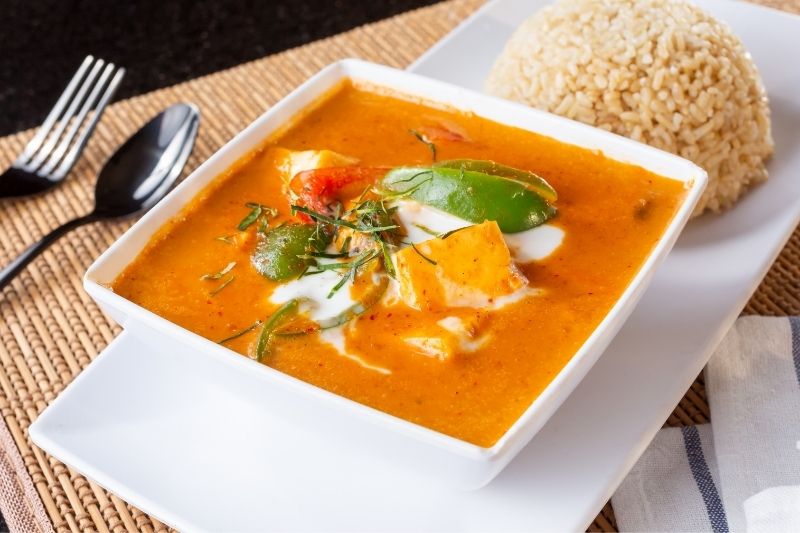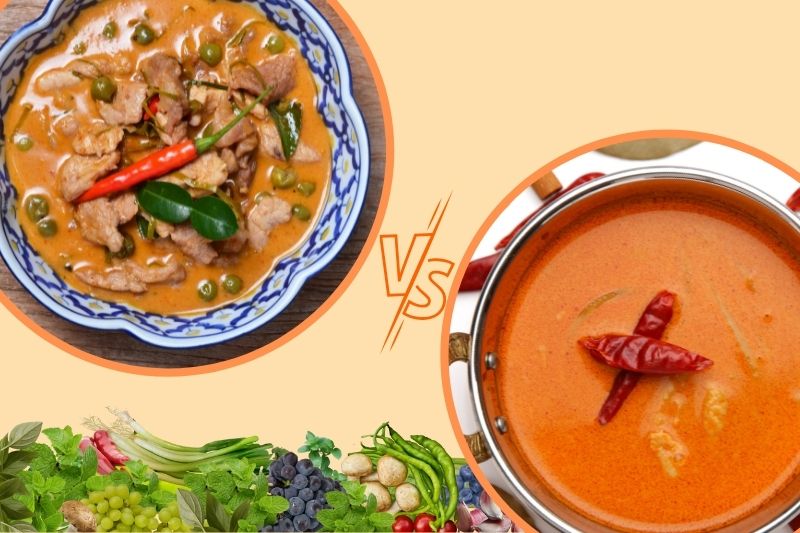Curries are a traditional part of Asian cuisine, but there are many different types with some more closely associated with certain regions.
Panang curry comes from Thailand and Malaysia and is one of the most popular types of Thai curry, along with red curry, green curry, and yellow curry.
Many people mistake red curry and Panang curry because of their similar colour but they’re not the same dish.
Here, we’ll take a look at both red curry and Panang curry and find out what the differences are.
Is Red Curry the Same as Panang?

Panang curry is often described as a type of red curry but that’s not the case. There are many different types of red curry, but Panang isn’t among them.
The reason that red curry and Panang curry are often confused is because they both have a red colour.
They are also both made from the same base which includes lemongrass, but there are some key differences between them.
If you were hoping for a traditional spicy red curry but were served a Panang curry instead, you’d be very disappointed.
Conversely, if you had ordered a delicious, sweet Panang curry, the heat from a red curry could be a huge shock.
What’s the Difference Between Red Curry and Panang Curry?
Both red curry and Panang curry use the same Thai curry base but that’s where the similarities end.
Red curries are, by definition, very spicy and contain a lot of heat. Chefs often use multiple red chilli peppers to achieve the necessary colour and spicy kick which red curries are known for.
The end colour of a red curry is very red, achieved by a combination of red ingredients including tomatoes, tomato paste, chilli flakes, chilli powder and fresh red chilli peppers.
Panang curry is also red, but the colour isn’t as vivid; it may sometimes even look pink. While there is a level of spice in a Panang curry, it’s usually quite mild. Chilli powder can be included but it’s not the dominant flavour that you would notice.
A Panang curry is much sweeter and has a nutty taste; this is because almonds are one of the core ingredients, and peanuts are sometimes added too.
There’s a warmth to a Panang curry but none of the extreme heat that you would expect from a traditional red curry.
The consistency of the two different types of curry is another telltale sign to look out for.
Panang curry is often thicker and creamier than red curry because it’s made with coconut cream. In contrast, red curry is made with coconut milk and tomato juice, giving it a runnier consistency.
Is Panang Curry Very Spicy?

Panang curry has some spice, but it’s much less than many other types of Thai curry.
Panang curry is nowhere near as spicy as red curry or green curry, and instead relies on a warmth that’s complemented by an earthy sweetness.
It is possible to make Panang curry with red chillies which would increase the heat. Like many curries, there are varying degrees of spiciness associated with a Panang curry and much depends on the individual making it.
However, as a general rule, you should expect Panang curry to have far less heat than either green curry or red curry.
What Flavour Is Panang Curry?
Panang curry can be made with a range of different proteins as well as vegetables, but the main flavour profile is sweet and nutty.
Panang usually has a thick, creamy consistency which carries a combination of sweet, salty, and spicy flavours. The taste of roasted peanuts is usually very noticeable, with an earthy background of almonds.

Chef’s Pick is your guide to the best kitchen equipment and appliances in the UK.
We help you understand the confusing world of cookers, ovens and cookware so you can get the most out of your kitchen.







